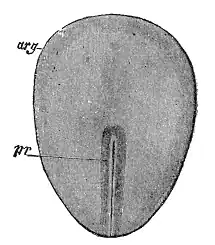Embryonic disc
| Embryonic disc | |
|---|---|
 Section through embryonic disc of a parti-coloured bat. | |
 Surface view of embryo of a rabbit. (After Kölliker.) arg. Embryonic disc. pr. Primitive streak. | |
| Details | |
| Carnegie stage | 4 |
| Precursor | Ectoderm |
| Identifiers | |
| Latin | discus embryonicus |
| TE | disc_by_E2.0.1.2.0.0.14 E2.0.1.2.0.0.14 |
| Anatomical terminology | |
The embryonic disc (or embryonic disk) forms the floor of the amniotic cavity. It is composed of a layer of cells – the embryonic ectoderm, derived from the inner cell mass and lying in apposition with the endoderm.
In humans, it is the stage of development that occurs after implantation and prior to the embryonic folding (e.g. seen between about day 14 to day 21 post fertilization). It is derived from the epiblast layer, which lies between the hypoblast layer and the amnion.[1] The epiblast layer is derived from the inner cell mass.[2] Through the process of gastrulation, the bilaminar embryonic disc becomes trilaminar. After this, the notochord forms. Through the process of neurulation, the notochord induces the formation of the neural tube in the embryonic disc.
References
![]() This article incorporates text in the public domain from page 47 of the 20th edition of Gray's Anatomy (1918)
This article incorporates text in the public domain from page 47 of the 20th edition of Gray's Anatomy (1918)
- ↑ Tan, Wen-Hann; Gilmore, Edward C.; Baris, Hagit N. (2013-01-01), Rimoin, David; Pyeritz, Reed; Korf, Bruce (eds.), "Chapter 15 - Human Developmental Genetics", Emery and Rimoin's Principles and Practice of Medical Genetics, Oxford: Academic Press, pp. 1–63, doi:10.1016/b978-0-12-383834-6.00018-5, ISBN 978-0-12-383834-6, retrieved 2020-11-13
- ↑ Neidhart, Michel (2016-01-01), Neidhart, Michel (ed.), "Chapter 13 - DNA Methylation and Development", DNA Methylation and Complex Human Disease, Oxford: Academic Press, pp. 229–240, doi:10.1016/b978-0-12-420194-1.00013-0, ISBN 978-0-12-420194-1, retrieved 2020-11-13
External links